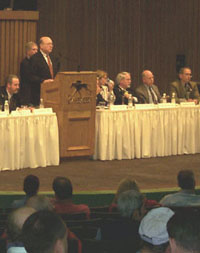Cyanide Implicated in Foal Losses
Cyanide Implicated in Foal Losses

While testing continues, the latest results indicate cyanide or cyanogenic compounds as the likely culprit in the death for hundreds of Kentucky foals in recent weeks.
Scott Smith, Dean of the University of Kentucky College of Agriculture, announced the hypothesis at an information sharing meeting Thursday at the Keeneland Sales Pavilion.
Wild black cherry trees are likely the source of these compounds with Eastern tent caterpillars directly or indirectly involved in the delivery to horses.
Smith cautioned that the current observation is preliminary and must yet be confirmed with further testing.
"We also wish to point out that, if confirmed, this working hypothesis would lead to a very positive outlook for prediction and prevention of recurrence of Mare Reproductive Loss Syndrome," he said.
UK agronomist Jimmy Henning said there is an extremely close association between the presence of wild cherry trees, the presence of Eastern tent caterpillars in very high numbers and both early foal loss and late term abortions.
"Therefore, this wild cherry/Eastern tent caterpillar complex has to be considered a leading suspect in the cause of the Mare Reproductive Loss Syndrome in 2001," he said.
This conclusion is strengthened by the finding that previous outbreaks of early foal loss were also correlated with high numbers of caterpillars, Henning said.
Tests show that white clover was not the source of cyanide on problem farms. Also, ergot alkaloids from bluegrass or orchardgrass were not the cause, nor were fescue toxicosis or mycotoxins a likely cause, Hennng said.
Eastern tent caterpillars tested May 4, were negative for cyanide, but retrospective inquiries indicate these caterpillars had not eaten cherry tree leaves or any plant material for more than six hours. That is important because anything ingested by the caterpillar passes through their intestinal tract in about six hours, said Dr. Lenn Harrison, Director of the UK Livestock Disease Diagnostic Laboratory.
A sample of preserved Eastern tent caterpillars taken April 20, is very strongly positive for cyanide, he said.
Wilted black cherry leaves are known to be toxic to cattle and sheep. Wilting leaves substantially increases the content and availability of cyanide. These same leaves are a favorite food of the Eastern tent caterpillar and this spring black cherry trees where stripped of their leaves by a large infestation of the caterpillars. Eastern tent caterpillars use cyanide as a defense mechanism.
Early results of tissue analysis from late term foals suggest cyanide, said Dr. Thomas Tobin, a professor at the UK Maxwell H. Gluck Equine Research Center Department of Veterinary Science. Cyanide causes death due to lack of oxygen in tissue and triggers a strong "gasp" reflex. Necropsy results were not inconsistent with death due to cyanide, he said.
Tobin said scientists will continue to work to confirm cyanide as the cause of MRLS and to trace cyanide back from mares to black cherry tree leaves.
More than 100 scientists and staff from the College of Agriculture along with veterinarians, farm managers, leaders in the equine industry and other governmental and private agencies have assisted in the search for the cause of MRLS.
"In my experience, the cooperative scientific and technical progress, made under the most urgent conditions, in essentially a three-week period, is unprecedented anywhere," Smith said. "This effort has been a model of communication and cooperation, and will continue to be."
Dr. David Powell, Extension Professor at the Gluck Equine Center, said the investigating team feels more comfortable with the information developed and more able to provide some practical advice to horse owners.
"I think we feel confident in saying at this stage, based on several reports, that the incidence has dropped off significantly and that we can make several observations," he said. "At this stage we consider there is no need be shipping mares out of Kentucky at this time.
Secondly, I think with the information available we can re-establish our mares on the pastures that they had been grazing, that the incident is past."
Powell said he feels confident that when the cause of the problem has been determined exactly and in fine detail that the scientists will be able to provide sound, practical advice to central Kentucky's horse industry.
